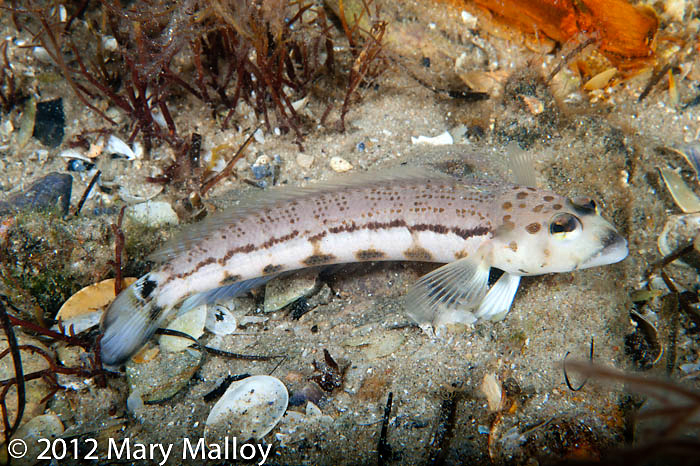Spotted Grubfish, Parapercis ramsayi (Steindachner 1883)
Other Names: Ramsay's Grubfish, Spotted Weever

A Spotted Grubfish, Parapercis ramsayi, in Port Phillip, Victoria. Source: Mary Malloy. License: All rights reserved
Summary:
A pale grubfish with large dark spots on the head, small greyish to brownish spots on the back, a dark brown wavy line or series of close-set spots along the upper side, large dark blotches along the lower side and a large black spot on the upper part of the tail base.
Video of a Spotted Grubfish in Camp Cove, Sydney Harbour.
A Spotted Grubfish at Old Mans Hat, North Head, Sydney Harbour.
Video of a Spotted Grubfish in Camp Cove, Sydney Harbour.
A Spotted Grubfish at Old Mans Hat, North Head, Sydney Harbour.
Cite this page as:
Bray, D.J. 2022, Parapercis ramsayi in Fishes of Australia, accessed 20 Apr 2024, https://fishesofaustralia.net.au/home/species/752
Spotted Grubfish, Parapercis ramsayi (Steindachner 1883)
More Info
|
Distribution |
Endemic to eastern and southern Australia with a disjunct distribution from NE of Yamba to Montague Island, New South Wales, Wilsons Promontory, Victoria, and from Victor Harbor, South Australia, to Guilderton, north of Perth, Western Australia. Inhabits sandy or muddy areas in the vicinity of reefs or other structures, preferring sheltered waters in protected bays, estuaries or deeper offshore reefs. Individuals swim by gliding above the seafloor, regularly perching on their pelvic fins to survey the surroundings. |
|
Features |
Dorsal fin IV, 24-25; Anal fin 20; Caudal fin 15; Pectoral fin 16-17; Pelvic fin I, 5; Lateral line scales 65- 67. Body elongate, shallow (15-17% SL), very little compressed; caudal peduncle of moderate depth. Head moderately small (27-29% SL), slightly depressed, moderately pointed; eyes large (22-27% HL), positioned dorsolaterally; interorbit narrow; mouth large, reaching below front edge of eyes; teeth pointed, broad band of small teeth at front of each jaw bordered by two rows of longer curved canines, one at front of jaw and one along each side; spine high on free margin of opercle; numerous fine pores evenly spread over head. Scales ctenoid, moderately small, covering body but absent from head; lateral line continuous, gradually descending to lateral midline on caudal peduncle. Dorsal fin continuous, with elongate base, short spinous section noticeably lower than, but broadly joined by membrane to soft portion, spines of similar length, soft portion of uniform height; anal fin with elongate base, slightly shorter and lower than soft portion of dorsal fin; caudal fin small, slightly rounded. Pectoral and pelvic fins of similar length, with middle rays longest, pelvic fins based below and slightly in advance of pectoral fin bases. |
|
Colour |
Pale greyish to brown above, whitish below, with large black spots in horizontal series low on sides; dark line or series of close set spots extending from gill opening to upper side of caudal peduncle; small dark spots on upper surface of body and large black spots on head; large black spot on upper side of caudal fin base; dorsal fin pale with dark area on spinous portion; anal fin bluish white with dark margin; caudal fin bluish white with broad dark margin and dark area along base; pectoral fin white basally, transparent distally; ventral fin white. Juveniles with yellow or orange, rather than black spots low on sides and white-edged black ocellus on caudal fin base. |
|
Feeding |
This "sit-and-wait" ambush predator is usually well-camouflaged on shelly bottoms. |
|
Etymology |
The species is presumaably named in honour of Edward Ramsay, Curator of the Australian Museum. |
|
Species Citation |
Percis ramsayi Steindachner, 1883, Anz. Akad. Wissensch. Wien 20(22): 194. Type locality: Gulf St Vincent, South Australia. |
|
Author |
Bray, D.J. 2022 |
|
Resources |
Spotted Grubfish, Parapercis ramsayi (Steindachner 1883)
References
Cantwell, G.E. 1964. A revision of the genus Parapercis, family Mugiloididae. Pacific Science 18(3): 239-280.
Coleman, N. 1980. Australian Sea Fishes South of 30ºS. Lane Cove, NSW : Doubleday Australia Pty Ltd 309 pp.
Gomon, M.F., Glover, C.J.M. & Kuiter, R.H. (eds) 1994. The Fishes of Australia's South Coast. Adelaide : State Printer 992 pp. 810 figs.
Hutchins, B. & R. Swainston. 1986. Sea Fishes of Southern Australia. Complete Field Guide for Anglers and Divers. Swainston Publishing. 180 pp.
Johnson, J.W. 2008. Pinguipedidae. pp. 670-673 in Gomon. M.F., Bray, D.J. & Kuiter, R.H (eds). Fishes of Australia's Southern Coast. Sydney : Reed New Holland 928 pp.
Kuiter, R.H. 1993. Coastal Fishes of South-eastern Australia. Bathurst : Crawford House Press 437 pp.
Kuiter, R.H. 1996. Guide to Sea Fishes of Australia. A comprehensive reference for divers and fishermen. Sydney, NSW, Australia : New Holland Publishers xvii, 434 pp.
May, J.L. & Maxwell, J.G.H. 1986. Field Guide to Trawl Fish from Temperate Waters of Australia. Hobart : CSIRO Division of Marine Research 492 pp.
Steindachner, F. 1883. Ichthyologische Beiträge (XIII). Anzeiger der Akademie der Wissenschaften in Wien 20(22): 194-197.
Thomson, J.M. 1978. A Field Guide to the Common Sea & Estuary Fishes of Non-tropical Australia. Sydney : Collins 144 pp.










